2019 Seminars
Patterns and mechanisms of Plio-Pleistocene climate change in southeastern Africa
November 20, 2019

Audrey Taylor is a third-year graduate student advised by Prof. Melissa Berke in the Department of Civil & Environmental Engineering & Earth Sciences. She presented "Patterns and mechanisms of Plio-Pleistocene climate change in southeastern Africa" at the ND Energy PD&GS Luncheon in November 2019.
Research in the Berke group examines sedimentary molecules to determine the characteristics of the past climate. By using these biomarkers, compounds indicative of certain kinds of life, Taylor aims to use the past to gain a better understanding of how climate might operate in the future. Specifically, she has studied the Plio-Pleistocene period, which is believed to have similarities to what we might expect in the near future.
“We’re using that as an analogue for future climate change,” Taylor said. “If we can figure out how climate responds in a certain region, we can determine how we need to adapt.”
As an undergraduate student at the University of North Carolina Wilmington, Taylor majored in physical geography with a minor in chemistry. Now pursuing her doctorate, the interdisciplinary work in the Berke lab allows Taylor to combine multiple research interests.
“I was really interested in climate and weather, as well as chemistry and ecology. This is the type of project that allows me to do everything without having to choose,” she said.
Taylor was also drawn to the prospects of doing her field study in various parts of the world. In addition to her prior project in southeastern Africa, she is looking forward to the opportunity to work in the Mediterranean to study the climate of Ancient Greece.
While in the field, Taylor collects sediment cores to bring back to campus for analysis. This further examination of samples is completed with instrumentation in the Berke lab and also the Center for Environmental Science and Technology (CEST).
“We go through a series of organic chemistry extractions to separate out the organic molecules from the sediments,” Taylor said.
Reflecting on her research, Taylor finds it intriguing how the complexities of the Earth’s systems can be understood through very simple ways.
“Using plant wax to look back at climate seems kind of crazy, but we can actually elucidate a lot of climate mechanisms and how climate has changed in the past,” Taylor said.
During her time in the lab, Taylor has learned a lot about analytical chemistry and has developed extensive technical skills in using the instrumentation on campus. She has passed this knowledge along through mentoring and training undergraduate students.
“It’s nice to show the students the full process and get them to the point where they can get data and analyze it,” Taylor said.
A standout scholar, Taylor has utilized resources through The Graduate School to secure funding for her research. She is a recipient of the Clare Boothe Luce Fellowship for Women in Science and Engineering, a program which aims to encourage women to study and teach in STEM fields. She also received funding from the National Science Foundation (NSF) through the highly competitive Graduate Research Fellowship Program (GRFP) in 2018.
A Flexibility Market-Based Approach to Increase Penetration of Renewables in the Power Grid
October 16, 2019
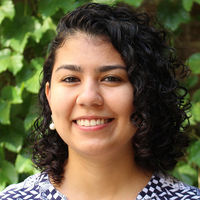
Nayara Aguiar is a fourth-year graduate student with Prof. Vijay Gupta’s lab in the Department of Electrical Engineering. She presented "A Flexibility Market-Based Approach to Increase Penetration of Renewables in the Power Grid" at the ND Energy PD&GS Luncheon in October 2019.
Aguiar is a recipient of a 2019 Patrick and Jana Eilers Graduate Student Fellowship for Energy Related Research. Her focus is designing and analyzing ways to make the electric grid more flexible to accommodate an increasing amount of renewable energy.
Because renewable sources are inherently intermittent, it is difficult to provide reliable, on-demand electricity at a high level of renewable penetration. Aguiar’s aim is to design new structures for electricity markets that promote collaboration among different energy sources. She has explored how natural gas power plants and energy storage systems can contribute for a more flexible grid.
“For this we leverage tools from power systems and economics,” Aguiar said of the interdisciplinary nature of the work. Among these tools are power flow analysis, game theory and mechanism design to evaluate the impacts of renewable uncertainty on the participation of different generators in the electricity market.
Despite having no formal background in economics when she started her research, Aguiar began studying potential relevant topics in the field. She was able to gain a better understanding on many of these economic theories once she began collaborating with Prof. Michèle Muller-Itten, assistant professor of economics at Notre Dame.
Renewable energy interested Aguiar while she was an undergraduate researcher at Federal University of Campina Grande in Brazil. Her research project investigated solar radiation data and analyzed various mathematical models to predict how much energy could be produced by a solar panel based on factors such as location and orientation. This experience provided a good match for working with Prof. Gupta.
Aguiar credits Gupta with providing connections for collaboration with researchers from other institutions, who contribute not only technical expertise but also broader perspectives. She highlights Prof. Pramod Khargonekar at the University of California, Irvine as someone who frequently raises questions to give Aguiar another viewpoint to consider.
“When you focus on just the technicalities, you can miss the bigger picture,” Aguiar said. “So having all of these mentors that I’ve met through my advisor has really helped me shape all of the aspects of my work and how it can influence society.”
Aguiar makes it a priority to attend many of the seminars and events sponsored by ND Energy throughout the year, such as the Energy Week discussion featuring Timothy Keller, mayor of Albuquerque, and Khalil Shalabi, executive vice president with the Lower Colorado River Authority, on solutions for renewable energy integration.
“Those types of talks give you a wider perspective about not only what people are doing in academia, but also what people are doing in the public sector and industry level,” Aguiar said.
Besides doing research, Aguiar is also very active in the Notre Dame community. In the past, she has volunteered with the Graduate Society of Women Engineers (SWE) and the STEMentorship Program through the Association for Women in Science (AWIS). Currently, she serves as the chair of the Book Club and as a graduate student liaison for the Institute of Electrical and Electronics Engineers (IEEE) Student Branch.
Radiation Effects of Solid Uranyl Peroxides
October 16, 2019
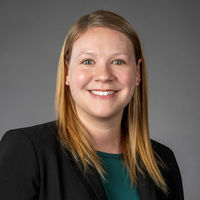
Melissa Fairley is a postdoctoral researcher working with Prof. Jay LaVerne in the Radiation Laboratory. She presented "Radiation Effects of Solid Uranyl Peroxides" at the ND Energy PD&GS Luncheon in October 2019.
Fairley came to Notre Dame in the fall of 2018 to work in the Actinide Center of Excellence (ACE). Led by ND Energy Director Peter Burns, ACE is funded by the National Nuclear Security Administration (NNSA). Research conducted at the center integrates both experimental and computational approaches to analyze radioactive materials. In addition to Burns and LaVerne, ND Energy affiliated faculty member Amy Hixon is also among the team of researchers in ACE.
“Actinides themselves are radioactive. In addition to self-radiolysis, applications in nuclear energy have harsh radiation fields,” Fairley said. “My research is looking at how uranyl peroxide materials are affected by intense radiation fields.”
Studtite, a uranyl peroxide mineral, has been found on stored fuel rods and uranyl peroxide cages have potential applications in the nuclear fuel cycle specifically with separation of uranium. By characterizing these materials before and after exposure to intense radiation, Fairley can observe if the materials break down, form new compounds, or if they remain stable and could potentially be used in these separation systems.
Fairley is a frequent user of ND Energy’s Materials Characterization Facility (MCF), for which she lauded both the staff and instrumentation. Fairley has been able to take advantage of the facility’s crystallography capabilities with the Powder XRD and conduct surface analysis with the XPS. She has also used the UV-Vis to study color changes due to irradiation.
“The instrumentation is phenomenal,” Fairley said. “There are so many instruments; if you’re wondering about something, you can do it there.”
The facilities in the Radiation Laboratory and the Nuclear Science Laboratory (NSL) have also been useful for Fairley’s research. Located in the Department of Physics, NSL houses the accelerator that Fairley uses to simulate alpha particles for irradiation.
As an undergraduate student at the University of Iowa, Fairley worked on synthesizing actinide nanoclusters. She later earned her Ph.D. at the University of Arizona with a focus on lanthanide clusters and metal-organic frameworks. The research done at Notre Dame through ACE provided an opportunity for Fairley to get back into the field of actinide chemistry.
“This project took something I was already interested in and expanded it,” Fairley said. “It’s important to understand how these materials are affected by radiation for applications in stockpile stewardship and nuclear energy.”
Fairley expects to be on campus for the next two to three years before moving on to a position in academia or a national laboratory.
Outside of the lab, Fairley has volunteered with ND Energy for outreach activities, including the annual Art 2 Science Summer Camp, as well as serving as a mentor with Advancing Women Leaders (AWL).
Interfacial Charge Transfer between Excited CsPbBr3 Nanocrystals and TiO2: Charge Injection versus Photodegradation
May 15, 2019
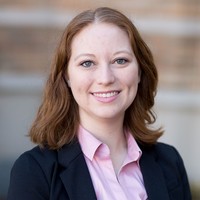
Rebecca Scheidt is entering her fourth year as a graduate student advised by Prof. Prashant Kamat in the Department of Chemistry and Biochemistry. She presented "Interfacial Charge Transfer between Excited CsPbBr3 Nanocrystals and TiO2: Charge Injection versus Photodegradation,” at the ND Energy PD&GS Luncheon in May.
In 2018, Scheidt received the Patrick and Jana Eilers Graduate Student Fellowship for Energy Related Research for her project looking at cesium lead bromide perovskite nanocrystals and how they operate in a photovoltaic device stack. Because these next-generation materials absorb light so well, these nanocrystal solar cells can be placed into thin film and flexible technologies.
“What I specifically look at is how they interacted with different charge transfer materials in the solar cell and whether that caused degradation under certain conditions,” Scheidt said. “In terms of making them more stable long-term, and looking at how they break down or degrade, we aim to make them more efficient overall.”
Scheidt is a frequent user of ND Energy’s Materials Characterization Facility (MCF). Using X-Ray Photoelectron Spectroscopy (XPS), she is able to see how the composition of these materials is changing as they degrade.
For her Eilers project, Scheidt worked directly with Elisabeth Kerns, a 2019 Energy Studies Minor graduate who was funded by the Vincent P. Slatt Fellowship for Undergraduate Research in Energy Systems and Processes.
As a Florida native, Scheidt recognizes the direct threat that climate change poses to her home state, and it drives her interest in her research.
“I’ve always been interested in conservation efforts and obviously climate change is a huge part,” Scheidt said. “Everything I love could be underwater in the next 50 years.”
Solar energy research, and the opportunity to work with Prof. Kamat, was a strong pull to bring Scheidt to Notre Dame. She enjoys the unique multidisciplinary nature of the Kamat lab.
“We do a lot of chemistry work, but we’re also very involved with chemical engineering and even physics at some points,” she said.
Outside of the lab, Scheidt is very active in various organizations on campus. As a graduate student representative with The Graduate School, she helps recruit other high-achieving graduate students to come to Notre Dame. She is also president of the Chemistry Graduate Student Organization, Notre Dame Electron Microscopy Club, and the Women Electron Microscopy Club.
Scheidt has been a standout associated researcher with ND Energy, earning a poster award at each of the first two ND Energy Research Symposiums. During Energy Week 2018, she gave a presentation on solar energy as a part of the Stinson-Remick Hall solar panel tours for students, faculty and staff.
Through her research experience, Scheidt has learned that sometimes a failed experiment is more important than a successful one.
“The quote I have above my desk is ‘a smooth sea never made for a skilled sailor,’” Scheidt said. “Science doesn’t always go your way. But you have to overcome that, and it really helps you learn the problem-solving ability.”
Design of Intrinsically Microporous Iptycene-based Polymers for Enhanced Gas Separation Membranes
April 17, 2019
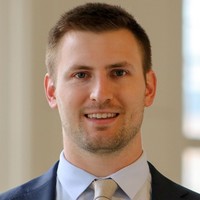
Tanner Corrado, third-year graduate student in Guo laboratory in the Department of Chemical and Biomolecular Engineering, presented "Design of Intrinsically Microporous Iptycene-based Polymers for Enhanced Gas Separation Membranes," at the ND Energy PD&GS Luncheon in April.
Prof. Ruilan Guo’s research focuses on developing polymeric membranes for various gas separation applications. Conventional separation processes, such as distillation, are highly energy intensive. As an alternative method, polymeric membranes are much more energy-efficient and produce a smaller carbon footprint.
“Most people won’t see the direct impact, but the overall reduction of energy consumption in these industrial processes results in lower costs and reduced emissions,” Corrado said, noting that their polymers can go into a wide variety of applications.
“One of the most prevalent of these applications is the purification of natural gas as a cleaner energy source while we transition to renewable energy,” Corrado said in reference to Notre Dame’s involvement with the Center for Innovative and Strategic Transformation of Alkane Resources (CISTAR).
For his research project, Corrado works with iptycene-based polymers of intrinsic microporosity.
“Iptycene is a promising compound because it can incorporate some natural permanent free volume into polymers, which helps it overcome some of its greatest challenges, which is performance reduction over time,” Corrado said.
Corrado studies the fundamental structure property relationships by making minor structural adjustments on the iptycene unit to determine how structural changes affect overall separation performance of the polymers.
“There’s a lot of patience involved with doing synthesis,” Corrado said. “A lot of the polymers we work with are novel, and we synthesize them from the ground up.”
Corrado studied chemistry at Linfield College in Oregon and had intended to continue his education at Oregon State University. However, after visiting Notre Dame, he was drawn to the research opportunities and sense of community the University provides.
“I was excited by all the young faculty in our department that were working on all these interesting research projects,” Corrado said, adding that it was exciting to be among the first groups to move into McCourtney Hall.
Beyond his research, Corrado is the Vice President of the Chemical and Biomolecular Engineering Graduate Student Organization (CBEGSO), previously serving for two years as social chair. He also works as a part-time graduate fellowship consultant for the Office of Grants and Fellowships.
In Spring 2018, Corrado was among 12 Notre Dame students and alumni who received the National Science Foundation Graduate Research Fellowship award. Fellows benefit from a three-year annual stipend, opportunities for international research and professional development, and the freedom to conduct their own research at any accredited U.S. institution of graduate education they choose.
Rare Earth Element Interactions with Uranium Oxides
April 17, 2019

Rebecca Carter, a fourth-year graduate student, is advised by Prof. Amy Hixon, assistant professor of civil and environmental engineering and earth sciences. She presented “Rare Earth Element Interactions with Uranium Oxides” at the ND Energy PD&GS Luncheon in April 2019.
Carter’s research is in the field of nuclear forensics, examining the safety and security of nuclear materials outside of regulated control.
“Characterization of materials is important in understanding their physical and chemical properties and developing their forensic signatures,” Carter said. These signatures can be used to trace unidentified nuclear materials back to their origins.
As an undergraduate student at Otterbein University in Westerville, Ohio, Carter studied environmental science. She cites a passion for addressing the environmental challenges posed by nuclear materials as her motivation for entering this field of research.
“We need to make sure we are cleaning up what we have left behind, and moving forward, we need to be responsible for what we’re producing,” Carter said. “If we can learn about how we can take care of that better, we can have safe and secure nuclear power.”
Her environmental science background pairs well with the environmental radiochemistry done in the Hixon lab. Much of Hixon’s research focuses on how actinides interact with the subsurface, in hopes of understanding and predicting their mobility.
“This would help us model for a potential geological repository, or the endpoint in which we’d hope to store nuclear fuel,” Carter said.
In addition to working in the Hixon lab, Carter has collaborated with another ND Energy faculty member, Prof. Antonio Simonetti, utilizing instruments at the Midwest Isotope and Trace Element Research Analytical Center (MITERAC). Specifically, she uses the Inductively Coupled Plasma Mass Spectrometer (ICP-MS), which allows her to look at the low concentrations of rare earth elements.
She also uses the Powder XRD and XPS housed in the Materials Characterization Facility (MCF).
“The fact that we can do anything in house is pretty awesome,” Carter said, praising the capabilities and facilities available on campus for materials characterization and nuclear research.
Carter believes it is important to communicate how this high level of nuclear research is done safely to combat the stigma associated with nuclear materials. As part of the Hixon group’s outreach efforts, Carter mentors a high school student through ND Energy’s Mishawaka High School internship program.
For her future plans, Carter had the opportunity to complete several internships at Pacific Northwest National Laboratory, and hopes to become a researcher at a national lab after she earns her Ph.D.
Bimetallic Phosphide Catalysts for Biomass Upgrading Reactions
February 20, 2019

Yolanda Bonita, fourth-year graduate student, is advised by Prof. Jason Hicks, associate professor of chemical and biomolecular engineering. She presented "Bimetallic Phosphide Catalysts for Biomass Upgrading Reactions," at the ND Energy PD&GS Luncheon in February.
Last year, Bonita received a Patrick and Jana Eilers Graduate Student Fellowship for Energy Related Research from ND Energy for her work in experimental catalysis. Her project centers around bimetallic catalysts for biomass conversion. Biomass is a promising renewable energy source derived from plant or animal materials due to its carbon-rich content.
“People often look at biomass as a source for fuel, but they don’t realize that it is also a great source for specialty chemicals,” Bonita said.
In her presentation, Bonita examined furfural, an organic compound, which can be obtained from biomass. While not useful on its own, furfural can be upgraded into various solvents, polymers, fuels, and other useful chemicals. However, the traditional catalyst used for this transformation, copper chromite, is prone to deactivation, the loss of catalytic activity over time. Additionally, the disposal of the chromite catalyst is toxic to the environment.
“My goal is to find a new catalyst to replace the industrial catalyst they’re using right now,” Bonita said. She has looked at several bimetallic compounds, such as ruthenium molybdenum phosphide.
“What we’ve found is that the selectivity is comparable to the commercial catalyst with significantly less deactivation rate,” she said.
Within their research, the Hicks group does a great deal of materials characterization, much of which can be conducted with the vast capabilities and instrumentation available on campus.
“The XRD is the very first characterization that I do whenever I make a material,” Bonita said. “And then the XPS can look at the surface properties such as composition and oxidation state, which a lot of times is related to the catalysis itself.”
Bonita lauded the powerful combination of ND Energy’s Materials Characterization Facility (MCF), the Center for Environmental Science and Technology (CEST), and the Notre Dame Integrated Imaging Facility (NDIIF) as a great resource for their research group and others on campus.
Beyond research, Bonita is a member of the Society of Women Engineers (SWE) and STEMentorship through the Notre Dame chapter of the Association for Women in Science (AWIS), which has allowed her to connect with the next generation of women in STEM fields as a mentor for undergraduates. Additionally, she has taken advantage of other outreach opportunities, including participating with ND Energy at Science Alive and the Expanding Your Horizons conference for middle school girls.
Dual-Functionalized Nanofiltration Membranes Exhibit Multifaceted Anti-Fouling and Ion Rejection Performance
February 20, 2019
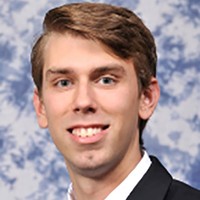
John Hoffman is a third-year graduate student in the Water purification and Advanced Transport Engineering Research (WATER) Laboratory. He presented "Dual-Functionalized Nanofiltration Membranes Exhibit Multifaceted Anti-Fouling and Ion Rejection Performance," at the ND Energy PD&GS Luncheon in February.
The WATER Lab is led by Prof. William Phillip, associate professor of chemical and biomolecular engineering. The group’s research focuses on membrane separations, which can be a more energy efficient method of water purification compared to traditional processes such as distillation.
Through a controlled reaction process, the group attempts to expand the performance and selectivity of copolymer nanofiltration membranes.
“We can take a membrane with high permeability and increase the functionality to have an additional reaction to reject something like salt from seawater,” Hoffman said.
Improvements to the desalination process can be vital in increasing freshwater reserves in places threatened by water scarcity such as Cape Town, South Africa or the western United States.
These systems can also be used for heavy metal recovery. Hoffman cited the situation in Flint, Michigan where 100,000 residents were exposed to dangerous levels of lead in their drinking water.
Hoffman’s hometown of Toledo, Ohio experienced a water shortage in 2014 with the Lake Erie algae crisis. For a few days, residents were unable to use their tap water, and the disruption served as a wake-up call.
“It kind of opened my eyes that some people have to deal with this issue every day of their lives,” Hoffman said.
Specifically, Hoffman targets fouling, a process by which the life expectancy of membranes can be rapidly reduced by contaminants in waste streams.
“We try to incorporate anti-fouling properties, as well as increase the ion selectivity by putting in charge functionalities on the pore wall,” Hoffman said. It is important to find a balance, he added, as too much charge functionality can actually make the fouling worse.
While an undergraduate student at the University of Toledo, Hoffman conducted a research project dealing with anti-fouling for medical applications. This work with similar polymeric surface coatings provided background knowledge and an interest in the field when he came to Notre Dame for graduate school.
Hoffman praised the University’s broad range of research opportunities, which allow students to address the kinds of challenges, such as access to clean water, that directly impact millions of people.
“We should have the ability to solve this, and we need to continue to push the boundaries on what we can achieve with membranes,” Hoffman said.
Investigation of Urine Electrolysis for Nitrogen Removal
January 16, 2019
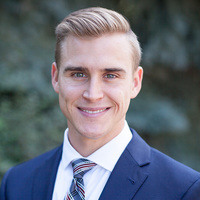
Andrew Schranck, fifth-year graduate student in the Doudrick lab in the Department of Civil and Environmental Engineering and Earth Sciences, presented “Investigation of Urine Electrolysis for Nitrogen Removal,” at the ND Energy PD&GS Luncheon in January.
“Urine contains a significant amount of nitrogen,” Schranck explained. In turn, the process to remove the nitrogen causes wastewater treatment facilities to have a large footprint, both in energy consumption and reactor size. Schranck is investigating how to treat the urine at the source.
In 2018, Schranck received a Patrick and Jana Eilers Graduate Student Fellowship for Energy Related Research from ND Energy for a two-part project. The first aspect centered on advancing electrochemical technologies to reduce the nitrogen burden at wastewater treatment plants, which would improve the energy efficiency of the process and reduce reactor size at treatment plants. The second component, which Schranck says he’ll be looking at over the next few months, is investigating the hydrogen produced by these systems as a potential fuel source for carrying out the nitrogen removal process.
Schranck’s undergraduate experiences while at Missouri University of Science and Technology inspired him to address problems in the food-energy-water nexus. A former varsity swimmer, Schranck attributes his fascination with water to being immersed in it. He spent time working on infrastructure projects throughout Latin America: participating in Engineers Without Borders in Bolivia, doing research on biosand filters in Brazil, and interning in Costa Rica.
“In the United States, we don’t even think about easy access to clean drinking water,” Schranck said, noting that many places around the world do not have reliable or affordable water sources.
After earning a dual bachelor’s degree in civil and architectural engineering, Schranck intended to pursue a master’s at Notre Dame. Despite not having extensive lab experience, Prof. Kyle Doudrick pitched the electrochemistry for wastewater treatment research to him, which convinced him he should continue on for his Ph.D.
“He told me as long as I found it interesting and in line with my academic and career goals, he would advise me through it,” Schranck said, adding that the University has a great support system for graduate students to conduct research.
After graduation, Schranck will begin a one-year fellowship in management consulting with enFocus, a civic innovation start-up in South Bend. The fellowship program empowers recent graduates to think like entrepreneurs to address the community’s greatest challenges.
Intercalation of Uranyl Peroxide Nanoclusters into Pillared Layered Double Hydroxides
January 16, 2019

Samuel Perry is a third-year graduate student in the Burns actinide lab. He presented "Intercalation of uranyl peroxide nanoclusters into pillared layered double hydroxides," at the ND Energy PD&GS Luncheon in January.
Perry is one of the recipients of the 2019 Patrick and Jana Eilers Graduate Student Fellowship for Energy Related Research from ND Energy. His research focuses on using synthetic layered double hydroxides to contain uranyl peroxide cage clusters in their interlayers. These materials could have useful applications in the nuclear fuel cycle as a component of engineered barriers in a spent fuel repository and for remediation of radionuclide contaminated sites.
While pursuing his bachelor’s degree at The Ohio State University, he worked on a research project for Prof. Wendy Panero examining the composition of deep Earth. He studied which of the lower mantle mineral-phases were most likely to host uranium and thorium, sparking his interest in the actinide elements. When it came time to search for a graduate school, the geochemical and materials science research of Prof. Peter Burns, director of ND Energy, was an ideal fit.
Although Perry came to Notre Dame to be a member of the Burns group, he believes this is a good university to perform research, citing the vast research capacity that continues to be strengthened. Perry highlighted the new laboratory space and newer equipment of the Materials Characterization Facility.
“There is no shortage of characterization instruments available,” Perry said of the facilities at the University.
Perry is an active volunteer for many of ND Energy’s outreach activities, from the annual Science Alive event at the St. Joseph County Public Library to Art 2 Science camp in the summer. He is also passionate about advocating for nuclear power.
“I like doing outreach to course-correct for any preconceived notions,” Perry said. While acknowledging the inherent challenges, such as safe disposal of nuclear waste, he believes public perception often exaggerates the dangers of nuclear energy.
Additionally, Perry’s career goal to become a professor drives his eagerness to introduce children to science and encourage them to think critically.
“Whether it’s a high-end research professor at a private university or teaching Geology 101 at a community college, I just like teaching,” Perry said of his future plans.